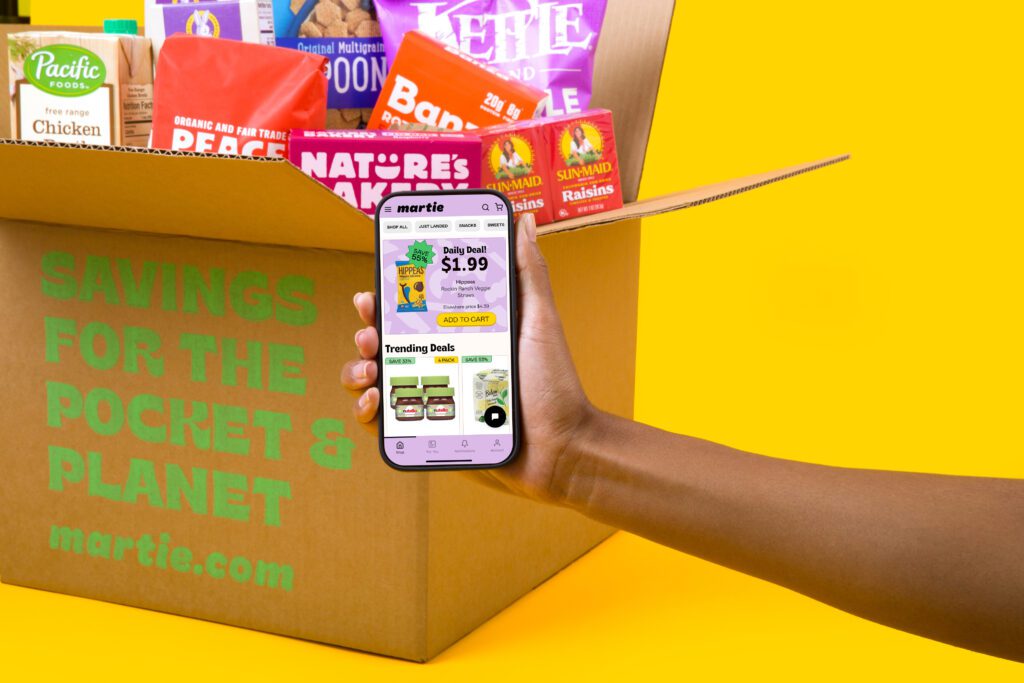It’s all about the mobile experience for Martie, an online grocery retailer.
Martie, which launched in November 2021, sells surplus groceries from food producers. The direct-to-consumer retailer launched with just a website, as it’s online-only. It launched its app in March 2022, and since then, its consumers have increasingly gravitated to it, cofounder Louise Fritjofsson told Digital Commerce 360.
What makes Martie different from its competitors, she said, is the focus on financial savings over time savings.
“When you start looking at the online grocery space, the mode has been convenience over everything,” Fritjofsson said. “We’ve pushed that to ‘get your groceries in 24 hours’ to ‘get it in a few hours.’ With the Gorillas of the world that came up like two years ago, you were supposed to be able to get your groceries in 20 minutes.”
That turnaround speed isn’t Martie’s goal — at least not yet.
“Martie is not that,” Fritjofsson explained. “We’re kind of convenient because you do get it to your doorstep, but you get it in three to five days. Where we are winning, our mode, is affordability.”
That’s also why Martie doesn’t sell fresh or frozen foods.

Image credit: Martie
Online grocery fulfillment through 3PL
Martie works with a third-party logistics (3PL) provider to pick, pack and distribute the groceries customers order online.
The 3PL, XPDEL, helps Martie ship nationwide through everyday carriers like USPS, UPS and FedEx. Fritjofsson said that, like other online grocers, Martie has 10 to 13 items in a box, on average.
“Anything dropship or similar would be very hard with the number of units that people pick and choose from,” Fritjofsson explained. “Currently, we ship nationwide from Texas. We ship with everyday, local, big carriers.”
Fritjofsson said Martie currently has 500 SKUs on its website and app. That number will be 1,000 in the next four months, she projected, which makes the 3PL relationship important to Martie’s operations.
Martie app takes command of retailer’s traffic
When it comes to traffic, Martie’s mobile app draws in more than half (52%). No other channel brings in more than a quarter of traffic, as 25% of Martie’s shoppers browse via desktop website and 20% using its mobile website. Just 3% browse its site via tablet. Martie currently has more than 50,000 users on its app.
Fritjofsson said everything Martie does has to be geared toward mobile browsing because 85% of the retailer’s website traffic comes from that source. She said that even though the mobile website and app are both meant for consumers’ phones, “people just linger longer and come back more often when it’s an app.” They don’t feel pressure to check out, she added.
She also attributes that growth in mobile app traffic to notifications.
“Your most loyal customers will look for and want the app,” Fritjofsson said. “There’s the segmentation to begin with. Someone who’s just testing you out and not sure will not go through the hassle to download the app. So, of course, you’re getting a more engaged audience on the app to begin with. But notifications are free to send.”
Notifications guide Martie app experience
Moreover, app notifications are different from other forms of communication with consumers, she said.
“You could send daily notifications to stay top of mind,” Fritjofsson said. “You’re not going to do that with any text messages, and email just doesn’t hit the same way. It also comes with a set of tools that are highly effective to make your users remember you.”
For example, she said, if Martie knows a consumer buys Ferrero chocolate, the retailer will let them know when it gets a new batch in. If a consumer doesn’t like — or just doesn’t buy — chocolate, then Martie “will not bother you with that specific notification,” she said. “We’re very product-centered in all of our notifications because product is king for Martie. The more we can make them personalized, the better they perform.”
Martie uploads between 150 and 200 new products to its website and mobile app every week, she said. Sometimes, Martie will add about 30 to 40 a day. Martie knows its consumers will open its app, Fritjofsson said, so the product it sells is a treasure hunt.
“We know that people on the app, they also just open the app for the entertainment factor,” she said. “What’s coming in? What’s a really great deal? The FOMO aspect. In that app experience, we have a different set of notifications, a different set of popups, a different set of categories and entertainment that we can offer because we know you will open it more often to be entertained and not necessarily always needing to shop.”
In contrast, she said the web-based user behavior is different. Martie’s website shoppers tend to exit quickly.
Do you rank in our database?
Submit your data with this quick survey and we’ll see where you fit in our next ranking update.
Sign up
Stay on top of the latest developments in the ecommerce industry. Sign up for a complimentary subscription to Digital Commerce 360 Retail News. Follow us on LinkedIn, Twitter, Facebook and YouTube. Be the first to know when Digital Commerce 360 publishes news content.
Favorite